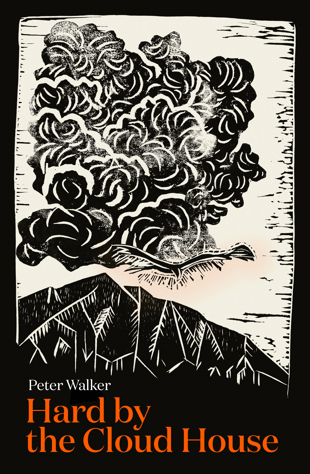Jenny Nicholls reviews Peter Walker's latest novel Hard by the Cloud House for Waiheke Weekender:
‘There is much to love about this book, which is ostensibly about the gigantic extinct New
Zealand raptor, Haast’s eagle. I say ‘ostensibly’ because if you are looking for an authoritative work on the largest eagle which has ever lived (that we know about), you have come to the wrong place. This isn’t a description of the lost bird, describing the latest science, with an index – it is a poetic ramble, beautifully written, wildly speculative – at its best, revealing and laugh-out-loud funny; at its worst, discursive and unconvincing.
Haast’s eagle was New Zealand’s apex predator. To its prey, a strike must have come out of nowhere, hitting with unimaginable power and speed. In 1989 the ornithologist Richard Holdaway described an attack as containing the force of “a concrete block dropped from the top of an eight-storey building.” This was, he explained, a bird which could fell an adult moa (weighing from 100 to 250 kilograms), at a single strike.
The author of this book, Peter Walker, is not a scientist, but he writes magnificently, dipping in and out of memoir, speculation, history, biology and travelogue, leaving out the scientific detail he thinks is boring or confusing. This can make for a fun read, although it leaves a lot of information about the eagle on the cutting room floor.
Those who know anything about the eagle will be confused by the book’s backcover blurb, which suggests that the ‘extinct giant eagle of New Zealand’ was confirmed ‘by scientists only in 2009’. Haast’s eagle was formally described way back in 1871. Holdaway wrote about it in 1989, and Walker himself doesn’t make this mistake in his text. The cover sales pitch surely refers to news stories in 2009 linking the great bird of Māori myth to Haast’s eagle (based on a study into the bird’s behaviour): the species had, by then, been studied for over 100 years.
I hope this minor confusion doesn’t put anyone off reading the book. The first half is a writerly masterpiece, including the clearest and most enraging account I have ever read of the swindling of Ngāi Tahu out of their South Island whenua. Walker excels at conjuring human beings out of dry historic narrative – he is less successful in building a convincing historic/scientific theory.
Best estimates put the extinction of the eagle at around 1445, and there are many reasons to think it briefly coexisted with Māori, including an awl dug up in Sumner Cave made from a great eagle bone. (The tool maker might have been using an old bone, although this seems unlikely).
Did the great raptor leave a giant bird shaped shadow in the deepest ravines of Māori collective memory? Could it be the legendary pouākai, or North Island hōkioi? Walker thinks the pouākai and Haast’s eagle are the same bird, a view he shares with many others. Māori legend, after all, describes a bird which lives in the mountains, a bird strong enough to pick up a man, a bird no longer seen. Walker’s confident ID of the North Island hōkioi as Haast’s eagle, based on an account given to Sir George Grey, has a less certain following, as it suggests a habitat for the eagle which isn’t backed up by a single confirmed fossil. Eagle fossils have, as yet, only been found in the east and northwest of the South Island (although Walker takes issue with this). Even fewer readers will be convinced by the author’s theory that Islamic mariners blew all the way to New Zealand, and saw the hōkioi/Haast’s eagle there, darkening the skies around Mount Taranaki.
My favourite chapters are in the first half of the book. The parade of cranky old geezers Walker meets during his researches is a category of bird which interests him even more, perhaps, than long-extinct eagles. Walker regales us with yarns about 19th century soapy Sams, eye wateringly stingy farmers, long buried government ministry scandals and curmudgeons like Phil Wood, of Phil Wood Menswear, Westport.
In 1980 Phil found a fossil treasure trove deep in a cave named Honeycomb Hill, including a large bone, ‘shaped like a spoon’.
“Wood was not a scientist — he sold menswear for a living — but he was an experienced caver, had found cave fossils before and knew this one did not belong to any species which was living or, so far as he knew, had ever lived in the forests above his head.”
The bone turned out to be an extraordinarily rare and precious wing bone from a Haast’s eagle. But Wood, says Walker, ended up feeling belittled by museum staff.
Walker flies from his home base in London to Westport, in part to meet Wood, although “my [telephone] conversations with Phil had been difficult, and each one seemed like a new test in which I got a lower mark.” After a warm reception, Walker is invited to Wood’s home, where the interview follows its by now familiar arc – “a flying start, some interesting information and then a sudden disjunction, the sound of a door being slammed.”
Walker is driven back to town “in silence.”
The author, a former Foreign Editor for the Independent on Sunday, has written for the Literary Review, the Financial Times books pages and Granta, so has quite the CV. He is an experienced interviewer, but in Westport he meets his Waterloo.
His friend, who had come with him to visit Wood, had been a journalist once, and joked: “Boy, you really messed that up.”
I hope the disgruntled Wood reads Hard by the Cloud House. He’ll love the line: “On the question of the eagle, Phil was right and the others were wrong.”
Walker says he wrote this book because he felt something was missing from the popular story of this legendary bird. “There should be more,” he writes.
Much as I love his book, this remains completely true.’


